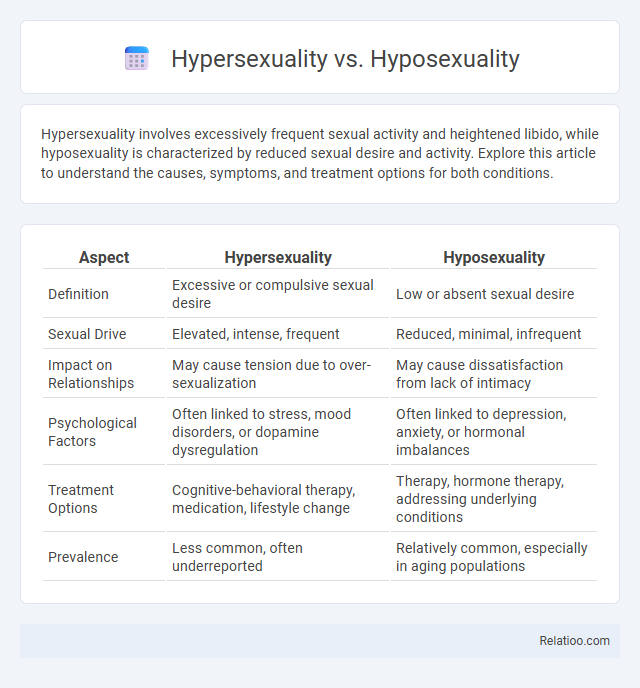Hypersexuality involves excessively frequent sexual activity and heightened libido, while hyposexuality is characterized by reduced sexual desire and activity. Explore this article to understand the causes, symptoms, and treatment options for both conditions.
Table of Comparison
| Aspect | Hypersexuality | Hyposexuality |
|---|---|---|
| Definition | Excessive or compulsive sexual desire | Low or absent sexual desire |
| Sexual Drive | Elevated, intense, frequent | Reduced, minimal, infrequent |
| Impact on Relationships | May cause tension due to over-sexualization | May cause dissatisfaction from lack of intimacy |
| Psychological Factors | Often linked to stress, mood disorders, or dopamine dysregulation | Often linked to depression, anxiety, or hormonal imbalances |
| Treatment Options | Cognitive-behavioral therapy, medication, lifestyle change | Therapy, hormone therapy, addressing underlying conditions |
| Prevalence | Less common, often underreported | Relatively common, especially in aging populations |
Understanding Hypersexuality and Hyposexuality
Hypersexuality is characterized by an excessive preoccupation with sexual thoughts, urges, and behaviors, often leading to distress or impairment in daily life, while hyposexuality involves a significantly reduced or absent sexual desire, which can impact personal relationships and self-esteem. Understanding hypersexuality requires recognizing its potential links to psychological conditions like bipolar disorder or impulse control disorders, whereas hyposexuality might stem from hormonal imbalances, medication side effects, or psychological factors such as depression or anxiety. Your awareness of these conditions can guide you to seek appropriate professional evaluation and treatment tailored to restore balanced sexual health and well-being.
Defining Sexual Desire Spectrum
The sexual desire spectrum ranges from hypersexuality, characterized by excessive or uncontrollable sexual urges, to hyposexuality, marked by diminished or absent sexual desire. Understanding where your experiences fall within this spectrum helps clarify whether sexual behaviors or feelings are within a healthy range or may indicate a need for medical or psychological intervention. Assessing the intensity, frequency, and impact of sexual desire on daily life is crucial for accurately defining your position on this spectrum.
Causes and Risk Factors
Hypersexuality often stems from neurological disorders, substance abuse, or psychological conditions such as bipolar disorder and obsessive-compulsive disorder, posing risks of relationship strain and mental health decline. Hyposexuality is usually caused by hormonal imbalances, chronic illnesses, medications, or psychological factors like depression and anxiety, leading to decreased libido and intimacy challenges. Both conditions highlight the critical role of neurochemical and hormonal regulation, with risk factors including genetic predisposition, trauma history, and environmental stressors.
Psychological and Biological Influences
Hypersexuality involves excessive sexual thoughts and behaviors often linked to imbalances in neurotransmitters like dopamine and serotonin, as well as psychological conditions such as bipolar disorder and obsessive-compulsive disorder. Hyposexuality, characterized by reduced sexual desire, can result from hormonal deficiencies including low testosterone or estrogen levels, and psychological factors like depression and anxiety disorders. These conditions underscore the complex interplay between biological mechanisms and psychological health in regulating sexual behavior.
Signs and Symptoms of Hypersexuality
Hypersexuality is characterized by an excessive preoccupation with sexual thoughts, urges, or behaviors that interfere with daily life, such as compulsive masturbation, multiple sexual partners, or risky sexual activities. Signs of hypersexuality include persistent sexual fantasies, impulsivity, and inability to control sexual behavior despite negative consequences. Your recognition of these symptoms can help differentiate hypersexuality from hyposexuality, which involves reduced sexual desire and activity, or sexual dysfunction conditions.
Signs and Symptoms of Hyposexuality
Hyposexuality is characterized by a decreased or absent sexual desire, often accompanied by difficulty becoming aroused or reaching orgasm, contrasting with hypersexuality's intense, persistent sexual urges and behaviors. Signs and symptoms of hyposexuality include reduced libido, lack of interest in sexual activity, and emotional distress related to sexual inactivity, which can negatively impact relationships and overall well-being. Your ability to recognize these symptoms is crucial for seeking appropriate treatment, as hyposexuality often stems from psychological, hormonal, or medical factors.
Impact on Relationships and Daily Life
Hypersexuality often leads to strained relationships due to compulsive sexual behavior, causing emotional distress and trust issues, whereas hyposexuality typically results in decreased intimacy and potential feelings of rejection between partners. Both conditions negatively impact daily life by disrupting emotional stability, affecting work performance, and reducing overall well-being. Understanding these sexual behavior extremes is crucial for effective treatment and maintaining healthy interpersonal connections.
Diagnosis and Assessment Methods
Diagnosis and assessment of hypersexuality primarily involve clinical interviews, self-report questionnaires like the Hypersexual Behavior Inventory (HBI), and screening for comorbid psychiatric disorders to distinguish it from compulsive sexual behavior or paraphilic disorders. Hyposexuality assessment includes evaluating libido levels through patient history, standardized scales such as the Arizona Sexual Experience Scale (ASEX), hormone level testing, and ruling out underlying medical or psychological conditions contributing to decreased sexual desire. Precise differentiation among hypersexuality, hyposexuality, and normative sexual variations requires a combination of structured diagnostic criteria outlined in the DSM-5 or ICD-11 and multidimensional assessment tools to guide targeted interventions.
Treatment Options and Approaches
Treatment options for hypersexuality center on cognitive-behavioral therapy, medication such as selective serotonin reuptake inhibitors, and support groups to manage compulsive sexual behavior. Hyposexuality treatment may include hormone replacement therapy, psychotherapy to address underlying psychological factors, and lifestyle modifications to enhance sexual desire. Both conditions require individualized approaches, often involving multidisciplinary teams to balance psychological, pharmacological, and social interventions tailored to the patient's specific symptoms and needs.
Seeking Support and Resources
Seeking support for hypersexuality and hyposexuality involves accessing specialized counseling services, such as certified sex therapists and mental health professionals experienced in sexual health disorders. Numerous organizations, including the American Association of Sexuality Educators, Counselors and Therapists (AASECT) and the International Society for Sexual Medicine (ISSM), offer resources, support groups, and educational materials to help individuals manage symptoms and improve quality of life. Online platforms and local clinics often provide confidential assessments and tailored treatment plans, emphasizing cognitive-behavioral therapy (CBT) and pharmacological interventions when appropriate.

Infographic: Hypersexuality vs Hyposexuality
 relatioo.com
relatioo.com